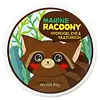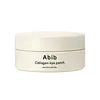What's inside
What's inside
 Key Ingredients
Key Ingredients

 Benefits
Benefits

 Concerns
Concerns

 Ingredients Side-by-side
Ingredients Side-by-side

Water
Skin ConditioningGlycerin
HumectantDipropylene Glycol
HumectantCarrageenan
Ceratonia Siliqua Gum
EmollientButylene Glycol
HumectantGlucose
HumectantSodium Hyaluronate
HumectantPotassium Chloride
Hydroxyethylcellulose
Emulsion StabilisingColloidal Gold 0.1%
AntimicrobialCyamopsis Tetragonoloba Gum
Emulsion StabilisingEthylhexylglycerin
Skin ConditioningMica
Cosmetic ColorantChromium Oxide Greens
Synthetic Fluorphlogopite
Disodium EDTA
Parfum
MaskingAloe Barbadensis Leaf Extract
EmollientCitrus Unshiu Peel Extract
MaskingCamellia Sinensis Leaf Extract
AntimicrobialAlgae Extract
EmollientRose Extract
Skin ConditioningChamomilla Recutita Flower Extract
MaskingPunica Granatum Fruit Extract
AntioxidantMelaleuca Alternifolia Leaf Water
AntimicrobialEucalyptus Globulus Leaf Extract
PerfumingHydrolyzed Collagen
EmollientGlycine Soja Seed Extract
Skin ConditioningCI 77499
Cosmetic ColorantEcklonia Cava Extract
Skin ConditioningGelidium Amansii Extract
Skin ConditioningHizikia Fusiforme Extract
Skin ConditioningSargassum Fulvellum Extract
Skin ConditioningUndaria Pinnatifida Extract
Skin ConditioningTitanium Dioxide
Cosmetic ColorantWater, Glycerin, Dipropylene Glycol, Carrageenan, Ceratonia Siliqua Gum, Butylene Glycol, Glucose, Sodium Hyaluronate, Potassium Chloride, Hydroxyethylcellulose, Colloidal Gold 0.1%, Cyamopsis Tetragonoloba Gum, Ethylhexylglycerin, Mica, Chromium Oxide Greens, Synthetic Fluorphlogopite, Disodium EDTA, Parfum, Aloe Barbadensis Leaf Extract, Citrus Unshiu Peel Extract, Camellia Sinensis Leaf Extract, Algae Extract, Rose Extract, Chamomilla Recutita Flower Extract, Punica Granatum Fruit Extract, Melaleuca Alternifolia Leaf Water, Eucalyptus Globulus Leaf Extract, Hydrolyzed Collagen, Glycine Soja Seed Extract, CI 77499, Ecklonia Cava Extract, Gelidium Amansii Extract, Hizikia Fusiforme Extract, Sargassum Fulvellum Extract, Undaria Pinnatifida Extract, Titanium Dioxide
Water
Skin ConditioningGlycerin
HumectantNiacinamide
SmoothingChondrus Crispus Powder
AbrasiveCollagen Extract
Skin Conditioning1,2-Hexanediol
Skin ConditioningBetaine
HumectantCeratonia Siliqua Gum
EmollientCyamopsis Tetragonoloba Gum
Emulsion StabilisingHydroxyacetophenone
AntioxidantChondrus Crispus
MaskingCalcium Chloride
AstringentAllantoin
Skin ConditioningButyrospermum Parkii Butter
Skin ConditioningPropanediol
SolventPolyglyceryl-10 Laurate
Skin ConditioningPolyglyceryl-3 Methylglucose Distearate
EmulsifyingPotassium Chloride
Anastatica Hierochuntica Extract
AstringentCellulose Gum
Emulsion StabilisingRicinus Communis Seed Oil
MaskingTrehalose
HumectantSucrose
HumectantCaprylyl Glycol
EmollientAdenosine
Skin ConditioningEthylhexylglycerin
Skin ConditioningDipotassium Glycyrrhizate
HumectantSodium Hyaluronate
HumectantCaffeine
Skin ConditioningPanthenol
Skin ConditioningCeramide NP
Skin ConditioningPalmitoyl Tripeptide-5
Skin ConditioningWater, Glycerin, Niacinamide, Chondrus Crispus Powder, Collagen Extract, 1,2-Hexanediol, Betaine, Ceratonia Siliqua Gum, Cyamopsis Tetragonoloba Gum, Hydroxyacetophenone, Chondrus Crispus, Calcium Chloride, Allantoin, Butyrospermum Parkii Butter, Propanediol, Polyglyceryl-10 Laurate, Polyglyceryl-3 Methylglucose Distearate, Potassium Chloride, Anastatica Hierochuntica Extract, Cellulose Gum, Ricinus Communis Seed Oil, Trehalose, Sucrose, Caprylyl Glycol, Adenosine, Ethylhexylglycerin, Dipotassium Glycyrrhizate, Sodium Hyaluronate, Caffeine, Panthenol, Ceramide NP, Palmitoyl Tripeptide-5
 Reviews
Reviews

Ingredients Explained
These ingredients are found in both products.
Ingredients higher up in an ingredient list are typically present in a larger amount.
Ceratonia Siliqua Gum is extracted from the seeds of the carob tree. You might know this ingredient as Carob Gum or Locust Bean Gum. It is used to stabilize other ingredients and improve the texture of products.
Carob gum is made up of long-chain polysaccharides. This makes it a natural thickener.
Yes! This ingredient comes from the seeds of a tree. The name 'Locust Bean Gum' can be misleading.
Learn more about Ceratonia Siliqua GumGuar gum is made from the guar bean, a plant native to India. It is considered a form of polysaccharide and naturally contains sugar.
This ingredient is often used to thicken a product or create a gel-like consistency.
It also has emulsion properties to help keep ingredients together.
Learn more about Cyamopsis Tetragonoloba GumEthylhexylglycerin (we can't pronounce this either) is commonly used as a preservative and skin softener. It is derived from glyceryl.
You might see Ethylhexylglycerin often paired with other preservatives such as phenoxyethanol. Ethylhexylglycerin has been found to increase the effectiveness of these other preservatives.
Glycerin is already naturally found in your skin. It helps moisturize and protect your skin.
A study from 2016 found glycerin to be more effective as a humectant than AHAs and hyaluronic acid.
As a humectant, it helps the skin stay hydrated by pulling moisture to your skin. The low molecular weight of glycerin allows it to pull moisture into the deeper layers of your skin.
Hydrated skin improves your skin barrier; Your skin barrier helps protect against irritants and bacteria.
Glycerin has also been found to have antimicrobial and antiviral properties. Due to these properties, glycerin is often used in wound and burn treatments.
In cosmetics, glycerin is usually derived from plants such as soybean or palm. However, it can also be sourced from animals, such as tallow or animal fat.
This ingredient is organic, colorless, odorless, and non-toxic.
Glycerin is the name for this ingredient in American English. British English uses Glycerol/Glycerine.
Learn more about GlycerinPotassium Chloride can be bad for oily skin and be bad for acne prone skin.
Sodium Hyaluronate is hyaluronic acid's salt form. It is commonly derived from the sodium salt of hyaluronic acid.
Like hyaluronic acid, it is great at holding water and acts as a humectant. This makes it a great skin hydrating ingredient.
Sodium Hyaluronate is naturally occurring in our bodies and is mostly found in eye fluid and joints.
These are some other common types of Hyaluronic Acid:
Learn more about Sodium HyaluronateWater. It's the most common cosmetic ingredient of all. You'll usually see it at the top of ingredient lists, meaning that it makes up the largest part of the product.
So why is it so popular? Water most often acts as a solvent - this means that it helps dissolve other ingredients into the formulation.
You'll also recognize water as that liquid we all need to stay alive. If you see this, drink a glass of water. Stay hydrated!
Learn more about Water